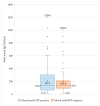Fungal Aeroallergen Sensitization Patterns among Airway-Allergic Patients in Zagazig, Egypt
- PMID: 36836300
- PMCID: PMC9961027
- DOI: 10.3390/jof9020185
Fungal Aeroallergen Sensitization Patterns among Airway-Allergic Patients in Zagazig, Egypt
Abstract
Background: Airway allergies such as asthma and allergic rhinitis, as well as their comorbidities, are increasing worldwide, causing significant socioeconomic health burdens to societies. It is estimated that between 3% and 10% of the population is allergic to fungi. The type of fungal sensitization varies from one geographical region to another. The present study aimed to identify the common fungal aeroallergen sensitization patterns among airway-allergic patients residing in the Zagazig locality, Egypt, in order to obtain a better understanding of fungal allergy, in addition to improving the awareness and management strategies for those patients.
Methods: The present cross-sectional study included 200 allergic rhinitis and asthma patients. Sensitization to fungal aeroallergens was evaluated by skin prick testing and in vitro measurement of total and specific immunoglobulin E.
Results: As determined by a skin prick test, 58% of the patients studied were allergic to mixed molds. Alternaria alternata was the predominant fungal aeroallergen among the studied patients (72.2%), which was followed by Aspergillus fumigatus (53.45%), Penicillium notatum (52.6%), Candida albicans (34.5%), and Aspergillus niger (25%).
Conclusion: Mixed mold sensitization ranked fourth among the most frequent aeroallergens in airway-allergic patients, and Alternaria alternata was the most frequently encountered fungal aeroallergen in the Zagazig locality.
Keywords: Alternaria alternata; Egypt; Zagazig; allergic-airway diseases; fungal sensitization; mixed mold; skin prick test; specific serum IgE.
Conflict of interest statement
The authors declare no conflict of interest.
Figures







Similar articles
-
Comparison of skin prick tests with specific serum immunoglobulin E in the diagnosis of fungal sensitization in patients with severe asthma.Clin Exp Allergy. 2009 Nov;39(11):1677-83. doi: 10.1111/j.1365-2222.2009.03339.x. Epub 2009 Aug 18. Clin Exp Allergy. 2009. PMID: 19689458
-
Fungi Sensitization in Spain: Importance of the Alternaria alternata Species and Its Major Allergen Alt a 1 in the Allergenicity.J Fungi (Basel). 2021 Aug 3;7(8):631. doi: 10.3390/jof7080631. J Fungi (Basel). 2021. PMID: 34436170 Free PMC article.
-
Alternaria alternata allergens: Markers of exposure, phylogeny and risk of fungi-induced respiratory allergy.Environ Int. 2016 Apr-May;89-90:71-80. doi: 10.1016/j.envint.2016.01.003. Epub 2016 Jan 28. Environ Int. 2016. PMID: 26826364 Review.
-
A review on hypersensitivity reactions to fungal aeroallergens in patients with allergic disorders in Iran.Curr Med Mycol. 2019 Mar;5(1):42-47. doi: 10.18502/cmm.5.1.537. Curr Med Mycol. 2019. PMID: 31049458 Free PMC article. Review.
-
Prevalence of immunoglobulin E for fungi in atopic children.Clin Exp Allergy. 2001 Oct;31(10):1564-70. doi: 10.1046/j.1365-2222.2001.01186.x. Clin Exp Allergy. 2001. PMID: 11678856
Cited by
-
Bayesian analysis suggests independent development of sensitization to different fungal allergens.World Allergy Organ J. 2024 May 17;17(5):100908. doi: 10.1016/j.waojou.2024.100908. eCollection 2024 May. World Allergy Organ J. 2024. PMID: 38800499 Free PMC article.
-
Fungi-sensitized individuals have unique profiles where Alt a 1 dominates promoting response to grass, ragweed and cat allergens.Front Allergy. 2024 Aug 23;5:1438393. doi: 10.3389/falgy.2024.1438393. eCollection 2024. Front Allergy. 2024. PMID: 39262766 Free PMC article.
References
-
- Hasnain S.M., Al-Frayh A.R., Subiza J.L., Fernández-Caldas E., Casanovas M., Geith T., Gad-El-Rab M.O., Koshak E., Al-Mehdar H., Al-Sowaidi S., et al. Sensitization to indigenous pollen and molds and other outdoor and indoor allergens in allergic patients from saudi arabia, United arab emirates, and Sudan. World Allergy Organ. J. 2012;5:59–65. doi: 10.1097/WOX.0b013e31825a73cd. - DOI - PMC - PubMed
-
- Hameed A.A.A., Khoder M.I., Emad A.A. Fertile fungal spores collected on different faced surfaces in the atmosphere of Giza, Egypt. Aerobiologia. 2007;23:47–57. doi: 10.1007/s10453-007-9048-0. - DOI
-
- Youssef Y.A., El-din A.K. Airborne spores of opportunistic fungi in the atmosphere of cairo, egypt. Grana. 1988;27:89–92. doi: 10.1080/00173138809427737. - DOI
LinkOut - more resources
Full Text Sources
Research Materials

